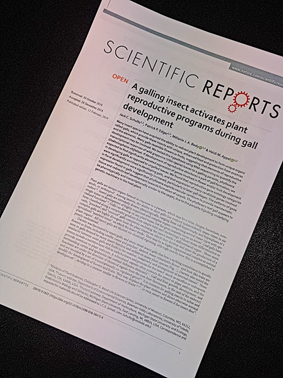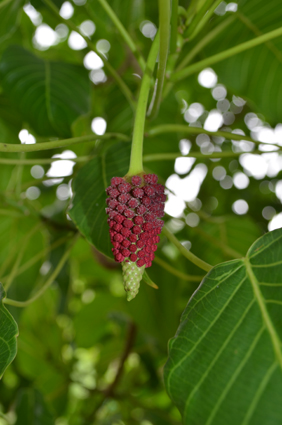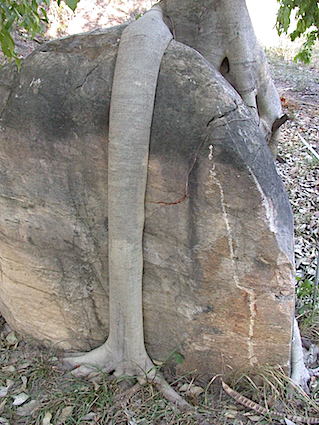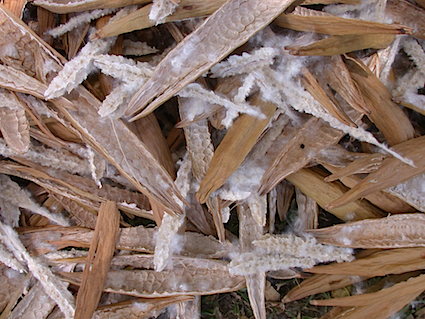Do you remember the tree urchin?
Back in 2012 I was amazed by the tree urchins, i.e. the fantastic red galls on Dipterocarpus tuberculatus. As it turned out, the insect responsible for this gall is indeed the aphid-related Beesonia dipterocarpi (Coccoidea) as discussed back in 2012.
A few months ago I was contacted by a research team who wanted the Dokmai Dogma gall picture for a publication. Being old and aware that my private library and photographs probably will end up in a waste bin, such a request was of course granted.
On Tuesday the article by Schultz, Edger, Body and Appel was published in Nature/Scientific Reports and contained their splendid research on the molecular biology of gall formation. In conclusion, the researchers showed that insects hijack the floral genes of the leaf cells to make a fruitlike structure which protects the insects rather than seeds.
Most cells in any multicellular organism contain the entire genome/DNA to encode the entire organism, i.e the cells of your toe have the blue prints to make your liver and brain. Since the leaf cells have the genes to make any plant structure including flowers and fruits, the insects unlock these dormant genes and start making structures resembling fruits or pistils.
How they unlock the dormant genes is still an enigma. One hypothesis is that their saliva contain plant hormones, but that would imply suitable receptors on the leaf cells’ outside membranes which seems unlikely, so it could be even more intricate, i.e. the insects manipulate the molecular locks inside the plant cell.
Is this research for nerds only? If we figure out how the insects unlock dormant genes in specialised plant cells, we might learn the trick and unlock dormant genes in specialised human cells, with huge medicinal applications such as making a new kidney or liver from your own white blood cells!

Eric Danell
Ton kwaw luang
The native orange-flowered form of Butea monosperma (ton kwaw) is the drought- and fire-resistant province flower of Chiang Mai. Its flowers are heavenly beautiful in December-January.
When I visited our beloved Dokmai Garden last July (off Butea’s flowering season) I walked past a site where I many years earlier (2007) planted a rare yellow cultivar of this monsoon species. During my years until 2013 it was always a sad looking rod with a handful of flowers, and since I did not notice it last summer I concluded it was dead. This cool season Khun Densak sent me a photograph of massive blossom in a tree so big he had to use a ladder to reach the flowers.
Last summer I apparently walked past its massive trunk without realizing it was my former shy juvenile. Many trees demand several years of establishment, and this sapling was planted in a sector which we never irrigate. The reason for selecting such a dry site was that monsoon natives do not bloom normally if their natural weather cycle is tampered with. A drought is needed for a massive blossom. It is also interesting to remember that the sad looking rod survived the overflow of the nearby quarry during the wet year of 2011, another unique feature of monsoon plants. In fact, indoor pot plants in the West are often of monsoon origin, being adapted to cope with long droughts and occasional floodings.

Huge and yellow Butea monosperma flowers are crowded on the bare branches. This is an example of a splendid ornamental for the dry garden where you save time, money and water by not irrigating. Other colourful tree species planted nearby in this dry corner are e.g. Delonix regia ‘Smather’s Gold’, Cochlospermum vitifolium, Jacaranda mimosifolia and Bolusanthus speciosus.

The old sign of the yellow Butea monosperma is now back to mark the site of a revered member of the Dokmai Garden, now twelve years of age. Its yellow flowers adorn the Dipterocarpus tuberculatus leaf litter.
Eric Danell
Santol pie
We are now back in Sweden, where an unusual drought with temperatures at 32-35 centigrades makes us feel just like home (in Thailand).
We brought back a santol fruit (Sandoricum koetjape, Meliaceae) from Dokmai Garden, where our trees grow without the need for irrigation. According to a Japanese study it is an important fruit for wild elephants in the Khao Yai National Park, and during our stay in Chantaburi province near Cambodia I saw various macaque monkeys eat the fruits. It has an interesting flavour reminding me of rhubarb, although its value as a fresh fruit is inferior to that of e.g. longan, mango and banana.
Different sources describe the fruit as a berry, drupe or capsule, indicating our limited knowledge of tropical fruits. My own conclusion after anatomical studies is that this is a fleshy indehiscent capsule where each seed is surrounded by a white and soft aril (sensu lato). This aril is difficult to remove from the seed.
I was curious if a santol dessert pie would be as delicious as a rhubarb pie. We therefore experimented with good results. The acidity of baked santol is weaker than that of rhubarb while the texture is more firm but not crispy. The reddish pieces had a meat-like resemblance.

Below is the recipe for the santol pie which we, after an initial sensory tasting, served with vanilla sauce.
1. Peel one mature yellow fruit with a potato peeler. Cut around the equator with a knife and twist the fruit so the seeds detach from one half. Remove and discard the seeds including arils from the other half. Cut the two seedless halves into thick slices.
2. Add the fruit slices to the bottom of an ovenproof dish greased with margarine.
3. Disperse 30 ml sugar and 5 ml ground cinnamon on top of the fruit.
4. Use your hands to mix 4 dl wheat flour with 200 g margarine and 30 ml sugar into a crumbly texture. Cover the fruit with this mixture.
5. Bake in the middle of the oven at 225 centigrades for 20 minutes.
Aroi!

Same girl and same tree 68 months later
In 2009 one of Dokmai Garden’s native pink shower saplings (Cassia bakeriana) lost its entire crown due to borers. I took the decision to cut the dead wood, leaving a pathetic stump and hope for a miracle. Three years later a new shoot had sealed the wound and replaced the crown. In the picture below my daughter Mia, at that time 8 months old, showed the position of the scar.

I thought the recovery was quite remarkable, but for how long time would the tree survive the ordeal? In the recent picture below, Mia, now 6 years and 4 months old, shows the same scar in the same tree.

So far so good! However, many trees die to faulty pruning, and even a professional cut can become infected, so this tree has been lucky.
As to the forest you see behind Mia, twelve years ago those trees were pencil-sized seedlings and all of them fit into the luggage compartment of a car. Children grow quickly!
Eric Danell
Old and new friends
So nice to meet old and new friends yesterday, representing e.g. the British Royal Horticultural Society, orchidology, plant physiology, marine biology, the Expats Club, oil industry, Thai agriculture and the Lanna Royal family. Avid gardeners from Australia, Esan, Lanna, Sweden, Switzerland, UK and USA mirrored the cosmopolitan Chiang Mai.
Since we all appreciate the rainy season the sky blessed us with a break in the rains so we could enjoy the discussions and Thai food outdoors. Absent friends may use the free app Curio xyz to home in on Chiang Mai and Dokmai Garden to see and read about some of our trees.
We thank everyone for joining!

Just back from the excursion at Dokmai Garden. From the left: Mia and Eric (Dokmai gardeners), John (New York marine biologist), Leif (board member of the Chiang Mai Expats Club), Mark (a Californian nursery man settled in Chiang Mai) and his wife H.R.H. Mae Nai (Lanna Royal family).

Organic treats from Dokmai Garden: lime (Citrus aurantiifolia), kalamondin (Citrus x microcarpa), caranda (Carissa carandas), banana (Musa acuminata (AA) ‘Gluay Khai’= ‘Sucrier’), mango (Mangifera indica) and santol (Sandoricum koetjape).
Cheers, Kate and Eric
Black bears in the trees
Upon our arrival to Chiang Mai and our beloved Dokmai Garden I noticed a multitude of large, black and hairy larvae on the trunks of our trees. They reminded me of black bears or skunks from a Walt Disney movie. The same larvae were observed in great numbers also in the nearby jungle at Opkhan and at a local tree nursery.
During my five years in Thailand I never noticed it before. I asked the manager of the nursery if she knew what they are, but she only used the northern Thai word for a caterpillar in general.
Since I was slightly worried this was a harmful pest, I began watching the larvae. The first observation was that they appeared on all sorts of unrelated tree species which is quite unusual. A tree’s chemical defence is often so advanced insects usually have to specialize in certain genera or families of trees. In this case they thrived on most trees, including e.g. mango, strychnine and golden shower from different plant families.
Secondly, the larvae did not eat leaves, nor wood, still they spent several days on the trunks of trees. A close look revealed they were actually feeding on the trunk, but not damaging the bark.
The anatomy of the larva, i.e. leg arrangement with anal claspers indicated it was a Lepidopteran, a moth. As it turns out, this larva is most likely a lichen moth, probably the diurnal Macrobrochis gigas (Erebidae).
Relieved these bear-looking larvae just feed on lichens, algae and cyanobacteria covering the tree trunks, I now enjoy their presence. The hairs are most likely irritating so I should follow the weaver ants’ precaution and not touch the larvae, but they are cute!
The reason insects some years appear in abundance is due to a fortunate combination of ideal weather and low numbers of natural predators, disease and parasitoids. A peak in population density is usually followed by years of declining numbers due to increasing numbers of natural enemies and disease.
In conclusion, there is no reason to worry. Relax and enjoy this rare moment. Soon they will grow up and fly away.
Eric Danell


See you at Dokmai Garden on Wednesday, July 18th 2018!
Dear friends of Thai flora,
At present we stay at Dokmai Garden during vacation. To catch up with friends and colleagues we invite you to a social gathering at Dokmai Garden next Wednesday, the 18th of July 2018 at 5 p.m. We offer snacks and refreshments, and Eric will demonstrate the tree app Curio xyz. Kindly let us know a day in advance if you wish to come: dokmai.garden at gmail.com
Most welcome!
Kate and Eric
Happy New Year with the novel app Curio-xyz for trees!
Dear friends of Thai flora,
It has been a long time since I wrote a blog for Dokmai Dogma. I am busy teaching dendrology, tree physiology and tree pathology at our arborist classes at Sweden’s largest gardening school Hvilan Utbildning. Meanwhile I get reports from our beloved Dokmai Garden. Little seedlings have grown into big trees with flowers and fruits. Apparently the native red kapok trees (Bombax ceiba) have flowered, and also the peculiar South American Cannon Ball Tree (Couroupita guianensis).
Last year, a new app, Curio-xyz, was launched which I believe will be a valuable tool for monitoring and teaching about trees. The app pinpoints your location, and shows a Google satellite image of your surroundings. If somebody has done the job, there will be coloured dots on the trees nearby your position. Click such a dot, and the name of the tree will appear, sometimes even with photographs and stories. The app is free and adapted to cell phone and web. I have introduced this app as a tool when we teach dendrology and tagged over 800 trees and shrubs in our Swedish school garden. The nearby Swedish university arboretum SLU Alnarp has registered thousands of trees and shrubs with Curio-xyz, and the nearby city Malmö has registered about 100 000 thousand street trees. If you think that is impressive, check out New York, more than 600 000 trees registered!
Are there any trees tagged in Thailand? Yes, the first native Thai tree ever tagged with Curio-xyz, and one of the first in Asia at all, was Dokmai Garden’s giant forest mango (Mangifera caloneura). I could comfortably tag it sitting at my desk at my office here in Sweden. Looking at Dokmai Garden from space makes my heart beat, and I recognize many individual trees, close friends of mine. However, to make sure my memory does not fail me I need to return to the spot and make sure the position of every tree is correct. After all, Dokmai Garden contains over 1100 different plant species, and one can only tag larger shrubs and trees.
The biggest obstacle at the moment for the Thai tree lover is the database. You can not just write a scientific name, you need to select from a list to avoid an accumulation of misspelt names. The list for the northern temperate region is rapidly expanding, even containing cultivar names, but for the tropics the Irish group behind Curio-xyz is negotiating to use a reliable database with accurate and modern scientific names.
Meanwhile, as you can see if you search for Chiang Mai and select Hang Dong district, you will see a restricted number of tree species at Dokmai Garden which I recently added to the database. The inventors of this app are keen to serve the user and reply pretty fast to comments and suggestions, so try their chat service!
Being a novel technique, Curio-xyz is still under development. A drawback is that the Google satellite images are old, and they are taken at a time when the sky is clear, i.e. the dry season when monsoon trees such as teak have shed their leaves, making such trees somewhat difficult to distinguish. It should also be emphasized that the images are useful for parks, gardens and streets, while the canopy cover in a forest makes tagging of individual trees difficult.
Why would you need a name of a tree? Once you have the name, you can google anything you want to know about the tree, from tree care and diseases to anecdotes and ethnobotany. Before you have the international scientific name, the tree remains a mystery or a source of confusion and misunderstandings.
With Curio-xyz, I believe amateur gardeners will learn a lot about trees, and purchase new exciting trees, and professional arborists and park managers can keep track of their gardens, parks and streets, and easily involve new staff without spending years showing around.
When iTree is fully incorporated with Curio-xyz, and adapted to different climates and tree species of our planet, a user can calculate the value of individual trees, and even design a future tree planting to optimise the ecosystem services in a neighbourhood.
For Thailand, the tourist from overseas can finally get the names already at the resort garden, quenching a thirst for a deeper knowledge of this beautiful country.
Happy New Year 2018!
Eric Danell

Impressions of an arborist student
Dear readers of Dokmai Dogma,
The blog still has around 200 readers a day in spite of me nowadays working in Sweden. At present I teach about trees in the temperate zone which is why I have not added any new blogs to Dokmai Dogma. However, below are the personal impressions by a student of mine, who spent a few weeks in July at Dokmai Garden.
Cheers, Eric Danell
The thought about an apprenticeship abroad was planted by Dr. Eric Danell, who all of you know from earlier blogs. It was more or less one of the first things he brought up when we started our eduction to become arborists late August 2015. At Hvilan Utbildning AB in Sweden, where he is teaching nowadays and I am being educated, he mentioned the possibility to gain experience in a more exotic environment, more precisely: Dokmai Garden. I was totally surprised about me being the only one in my class actually flagging for having interest in the idea. Now I am looking back at a very giving experience. I mean, where do you have the possibility to work with so many different species? When will you have the possibility to do whatever you feel makes most sense? Sure, there were some challenges as well. I was offered housing in the traditional home of a beautiful Thai couple, but they did not speak English. Furthermore, physical labour in this climate is something you will have to get used to and work pace needs to be reduced substantially. You will have to drink liters of extra water during the day. Aggressive tree-ants will take any possibility they get to make your life miserable and so do mosquitos and other insects. However, you get used to all this rather soon, surprisingly enough.
The first thing you will notice when you walk around at Dokmai Garden is that all has been very well made. This is a place in which people invested without compromising on quality. The entrance with a spacious parking lot, the beautiful gates, the conference building, facilities for personal hygiene. The garden itself is an interesting collection of species that are asking to be touched. I mean: the garden is rather young, as much of the vegetation was planted only around 2009. The fact that over here all grows quite a bit faster than back in Sweden makes that there is an even stronger need for young trees to be trained. With a pruning saw and pruner to be preferred over machete, if I may choose. I was offered quite some suggestions about what I could do during my almost 3 week stay, but soon found that I would never be able to tick all the boxes. During the first days I lost myself in the teak and longan plantation, deadwooding and training each individual tree in this part of the garden. And as I thought it would be a great idea to work as efficiently as possible I simply continued pruning until I was completely done, after which I soon found that pulling branches more than one full day is actually far less fun, especially in this climate.
From then on I initiated smaller projects that I completely finished before moving on. 1 project being one tree, or a smaller group of trees. I did climb at the garden, but in many cases climbing simply is impossible due to tree-ants that will attack you altogether if they get a chance. Their bite is not dangerous, just painful. Though: I did find that climbing a Samanea saman (Rain tree) is at least as challenging as climbing an oak, as it has such a wide canopy, with the distinction that you feel far less certain about durability of branches when climbing unfamiliar tree species. But you take the opportunity you get to do some climbing and on the beautiful small sign next to the Gmelina arborea (Snapdragon tree) I read that durability of its wood is strong. I was taught that in Hopea odorata a dangerous female spirit is living that will haunt you if you would fell this species without monks having taken precautions. You can imagine I pruned this one with extra care! Furthermore, I promised myself to marry the one who smells like blossoming Plumeria obtusa everyday of the year, despite that fact that this one cannot be referred to as a collector’s item.
To anyone who is a student in arboriculture: can you please promise me to take the opportunity to gain an experience like this when offered?
Text and Photo: Adrian

Characteristic bark of Bombax ceiba.

Male flowers of Hura crepitans.

Red sap of the durable native timber tree Pterocarpus macrocarpus.

Not my friends…(red weaver ants).
Dokmai Garden revisited
Dear friends of Thai flora,
Due to an overwhelming workload in Sweden we have not had time for tropical Dokmai Dogma blogs. However, we paid a swift visit to Dokmai Garden in Chiang Mai this July, and so we wish to share some impressions.
We arrived in the midst of the El Niño drought, but since we have experienced such droughts before we were not worried, confident our selection of hardy plants would survive like last time. In fact we eventually received some 20 mm of rain, and in two days the landscape changed into a jade green, although teaks and other deciduous trees had already decided to shed their leaves. Flowering trees which normally display their beauty in the (normal) drought of April started flowering all over again (e.g. Delonix regia and Cassia fistula).
The garden was full of birds and butterflies, including the endangered golden birdwing butterfly. Neighbours had noticed this island of life too. Of course they wanted to know how to achieve such biodiversity. The answer has been hinted in Dokmai Dogma blogs before; establish a broad range of plant species providing shelter for birds, food for butterfly larvae, fruit, pollen and nectar, and stay away from fire and pesticides! We were also pleased to see that the quarry still contained water in spite of the drought, and there were still plenty of native fish, many of which have become quite large (e.g. giant gourami). During rainy La Niña years the quarry fills up, but Dokmai Garden is naturally drained so unlike the rice field areas around town we are never flooded.
In addition to the wild fauna, Dokmai Garden has new zebu cows, many white ducks and many more chicken including black-skinned (white-feathered) chicken. The sheep have become mutton, as they destroyed many plants, including treasured bananas.
To our great joy most of the orchids that were mounted in the trees until 2013 have survived and many are naturally reproducing. One example is the orchid Aerides multiflora, which never produced fruit until this year when we counted 57 capsules! This hints that the garden keeps evolving and attracting more species, including the elusive pollinator of this orchid.
Although we lost the Mediterranean plants which apparently needed Eric’s love and care, the native monsoon trees have grown rapidly. The payom, Shorea roxburghii, which has a valuable timber and is one of the best natural substrates when orchid seeds germinate, have grown to such an extent the five trees confused our orientation. They seem to have doubled their size in 18 months! The Benjamin fig, Ficus benjamina, has grown at an amazing speed too. A tiny seedling which originally germinated on a log was fastened to a rock six years ago, and its roots dispersed to eventually create a giant claw grasping the rock. This strategy has worked very well because the current impression of this fig tree is that of liquid roots. They look like they were made of melted metal.
Another native fig that has left childhood is Ficus racemosa. For the first time in its life it produces impressive amounts of red fruits to the joy of birds, insects and humans:
The ebonies are getting taller too, and we had a bountiful crop of santol fruit (Sandoricum koetjape). We also admired the height and health of the little known native tree Protium serratum. Although we could see its edible fruits, they were still immature. Many more delicious and rare fruits are expected over the coming years. The local climate of the garden is much cooler today thanks to the unbroken canopy of the monsoon woodland in the southeast. Humans can no longer reach the lowest branches in many trees, and like proud parents we remember that in June 2006 this entire woodland was gathered as seedlings in the back of our car! The native but rare rosewood (Dalbergia oliveri) has also grown rapidly. We should strongly recommend planting this native and gorgeous tree in Chiang Mai. Not primarily because of its valuable and beautiful wood, but because it can resist drought and has blue blossom and a lovely foliage which is red when the buds burst.
The area surrounding Dokmai Garden is developing quickly, with new houses and a brand new gasoline station, café, convenient store open 24/7 and ATM about 2 km away. The transformation of the canal road into a four lane freeway will commence in 2017. Being 2 km away we can not hear the traffic, but still rapidly access civilization when needed. The canal road is already the main route between town and the Doi Inthanon national park, which we of course also visited during our short stay.
See ya!
Ketsanee Seehamongkol & Eric Danell
Harvest of Dokmai Garden kapok fruits (Ceiba pentandra) for filling of cushions







